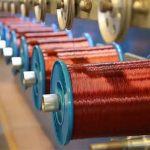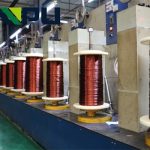Transformers play a fundamental role in electrical power distribution, facilitating voltage transformation and minimizing energy losses. Achieving high efficiency in transformers is essential for reducing power consumption and greenhouse gas emissions. The choice of magnet wire, the primary component of transformer windings, significantly impacts overall performance.
Wire Gauge Selection
Selecting the appropriate wire gauge is crucial for maximizing transformer efficiency. Larger wire gauges (lower AWG numbers) offer lower resistance and reduced resistive losses, while smaller gauges (higher AWG numbers) provide higher packing density and lower eddy current losses.
Wire Material
The choice of wire material significantly influences transformer performance. Copper and aluminum are the most common materials used for magnet wire. Copper boasts superior electrical conductivity, making it the standard choice for high-efficiency transformers. However, aluminum offers cost advantages and reduced weight.
Insulation Material
Insulation plays a critical role in preventing electrical short-circuits and minimizing losses due to corona discharge. Different insulation materials, such as enamel, paper, and polymeric films, have varying dielectric properties and temperature ratings. Selecting the appropriate insulation material is essential for ensuring reliable transformer operation and efficiency.
Thermal Properties
Transformers generate heat during operation, and excessive heat can lead to performance degradation and reduced efficiency. The thermal conductivity of the magnet wire and its ability to dissipate heat impact overall transformer reliability. Engineers should consider the thermal properties of the chosen wire to avoid overheating issues.

Frequency Considerations
For transformers operating at high frequencies, skin effect and proximity effect become more pronounced. These phenomena lead to increased resistance and losses in the wire. Stranded wire configurations can mitigate these effects, contributing to enhanced efficiency.
Design and Geometry
The design and winding geometry of transformers also influence magnet wire selection. Engineers must consider factors like wire arrangement, core shape, and coil structure to optimize efficiency and minimize leakage inductance.
Environmental and Cost Considerations
Environmental sustainability and cost-effectiveness are increasingly vital in transformer design. Recycling considerations and the ecological impact of wire materials should be weighed against economic factors to make environmentally responsible and economically viable choices.
Conclusion
Choosing the right magnet wire is crucial for maximizing transformer efficiency and minimizing energy losses. Engineers must carefully evaluate wire gauge, material, insulation, thermal properties, frequency considerations, and design aspects to achieve high-efficiency transformers. By understanding the impact of these factors, manufacturers can contribute to a greener and more energy-efficient future.
LP Industry can produce magnet wires according to your requirement with best prices, check our website to learn more: transformer-wire.com






